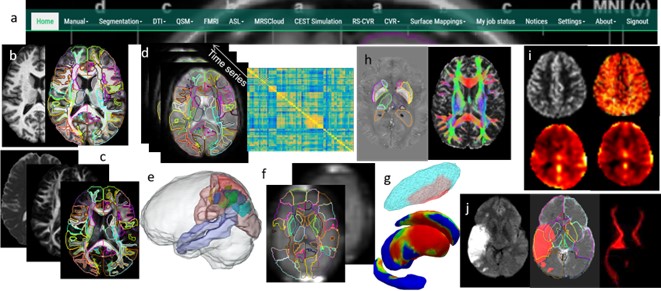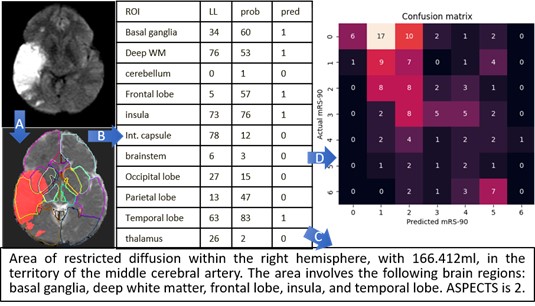Over the past decades, machine learning has advanced significantly, with many tools now available for diverse image analysis tasks. Anatomical segmentation methods have matured, especially multi-atlas approaches—an early form of machine learning based on labeled atlas libraries, though distinct from deep learning. Deep learning offers faster large-scale processing but still faces challenges such as data scarcity, heterogeneity, bias, and lack of interpretability.
We are developing hybrid approaches that combine the efficiency of deep learning with the accuracy and transparency of classical statistical methods. Our team is well positioned for this work, with extensive expertise, data resources, and established tools. We created MRICloud (e.g. See Figure 1), a cloud-based platform that enables complex neuroimaging analysis through a web interface, removing the need for local computing. MRICloud was recently refactored into a modular architecture, allowing easy integration of DL-based algorithms. We implemented a whole-brain segmentation method combining registration and deep learning, reducing processing time from hours to minutes.

Figure 1. Overview of MRICloud services, deployed and in development (a), including pre-processing, mapping to common space, brain segmentation, and ROI-based quantification of: b) high-resolution T1-WIs, c) DWIs, with scalar image calculation and tract-based segmentation, d) resting state fMRI, e) automated tractography and integration of connectivity analyses, f) MRS simulations and MRSI metabolite estimation, g) Surface calculation, cross-sectional and longitudinal analysis, h) SWIs, iron content estimation, computation of QSM and STI, i) ASL and CVR, with CBV, CBF, ATT, rs-CVR calculation, and regional estimation of vascular indices, j) lesion detection, segmentation and characterization in clinical images, computation of disconnectome maps.
We also have access to large, diverse datasets for tool development and validation. We created StrokeFAIR1, a stroke imaging knowledgebase of nearly 3,000 patients and over 50,000 annotated multimodal MRIs, with associated metadata. We developed and deployed tools like ADS4 for brain lesion segmentation, quantification, and structural analysis, with a focus on clinical integration and usability (See Figure 2). Additional resources include vascular atlases2 and tools for infarct segmentation3, territory-specific quantification, and clinical scoring4,5. These led to groundbreak discoveries with our collaborative projects.

Figure 2. (A) Automated stroke detection, segmentation (red), and localization using a customized digital atlas overlaid on DWI. (B) This allows extraction of lesion loadings (ll), reflecting the proportion of injury per brain region, which are used as CDOs for probabilistic (”prob”) and binary prediction (”pred”) of regional injury. Applications include predicting clinical indices at personal level (e.g., ASPECTS; confusion matrix (D)) and generating comprehensive radiology reports (C)
We continue expanding our analytical tools for multimodal MRI, including DWI, perfusion, metabolic, and susceptibility-weighted imaging. Building on this foundation, we will integrate traditional and AI- based methods for segmentation, quantification, and multimodal data fusion in healthy and pathological brains. We will develop lesion quantification algorithms, generate bias-corrected image phenotypes, and implement encoding and latent feature representation methods, laying the foundation for future models and reproducible, AI-driven biomarker discovery.
- Liu, C.-F. et al. A large public dataset of annotated clinical mris and metadata of patients with acute stroke. Sci. Data 10, 548 (2023).
- Liu, C.-F. et al. Digital 3d brain mri arterial territories atlas. Sci. Data (2022).
- Liu, C.-F. et al. Deep learning-based detection and segmentation of diffusion abnormalities in acute ischemic stroke. Commun. Medicine 1, 1–18 (2021).
- Liu, C.-F. et al. Automatic comprehensive radiological reports for clinical acute stroke mris. Commun. Medicine 3, 95 (2023).
- Liu, C.-F. et al. Automatic comprehensive aspects reports in clinical acute stroke mris. Sci. reports 13, 3784 (2023).
